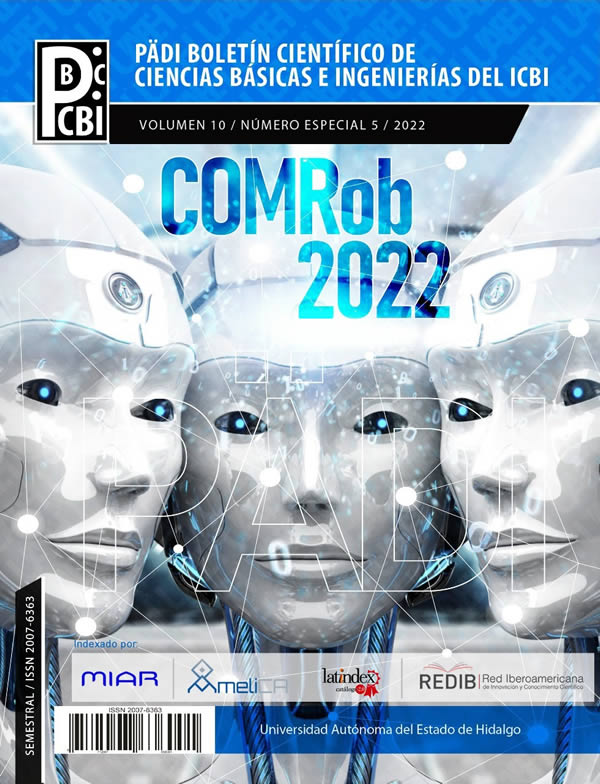Neuro-robust control of leader-follower system of mobile agents
Abstract
In this work applying output feedback linearization, a neuro-robust controller based on a recurrent high-order neural network is proposed, applied to differential drive mobile robot tracking. The tracking is done on the the wheels angular velocities. The strategy consists in desing a linearizing controller and an estimator based on neural networks for the parametric uncertainties and possible discrepancies in the model. In this way only angular velocities are required as output variables. A numerical simulation is presented to illustrate the proposal.
Downloads
References
Dhaouadi, R. y Hatan, A. A. (2013). Dynamic modelling of differential-drive mobile robots using lagrange and newton-euler methodologies: A unified framework. Advances in Robotics and Automation, 2:107.
Femat, R., Alvarez-Ramirez, J., Castillo-Toledo, B., y Gonzalez, J. (1999). On robust chaos suppression in a class of nondriven oscillators: application to the chua’s circuit. IEEE Transactions on Circuits and Systems I: Fundamental Theory and Applications, 46(9):1150–1152.
Femat, R. y Solis-Perales, G. (2008). Robust Synchronization Via Geometrical Control: A General Framework, pp. 99–137. Springer Berlin Heidelberg, Berlin, Heidelberg.
Hassan, N. y Saleem, A. (2022). Neural network-based adaptive controller for trajectory tracking of wheeled mobile robots. IEEE Access, 10:13582–13597.
Hikrobot, C. (2022). Latent mobile robot.
Hopfield, J. J. (1984). Neurons with graded responses have collective computational properties like those of two state neurons. Proc. Nat. Acad. Sci, 81:3088–3092.
iRobot Corporation (2022). Roomba.
Isidori, A. (1995). Nonlinear Control System. Springer-Verlag, 3 edición.
Khalil, H. (2002). Nonlinear Systems. Pearson Education. Prentice-Hall, Upper Saddle River, NJ, 3 edición.
Kosmatopoulos, E., Polycarpou, M., Christodoulou, M., e Ioannou, P. (1995). High-order neural network structures for identification of dynamical systems. IEEE Transactions on Neural Networks, 6(2):422–431.
Kosmatopoulus, E., Chistodoulou, M., e Ioannou, P. (1997). Dynamical neural networks that ensure identification error convergence. Neural Networks, 10(2):299–314.
KUKA (2022). Intelligent automated guided vehicle systems revolutionize the future of production.
Lian, K.-Y., Hsu, W.-H., y Tsai, T.-S. (2019). Leader-follower mobile robots control based on light source detection. IEEE Sensors Journal, 19(23):11142–11150.
Majid, N., Mohamed, Z., y Basri, A. (2016). Velocity control of a unicycle type of mobile robot using optimal pid controller. Jurnal Teknologi, 78.
Meng, J., Liu, A., Yang, Y., Wu, Z., y Xu, Q. (2018). Two-wheeled robot platform based on pid control. En 2018 5th International Conference on Information Science and Control Engineering (ICISCE), pp. 1011–1014.
Rabbani, M. J. y Memon, A. Y. (2021). Trajectory tracking and stabilization of nonholonomic wheeled mobile robot using recursive integral backstepping
control. Electronics, 10(16).
Ricalde, L. (2005). Inverse optimal adaptive recurrent neural control with constrained inputs. Tesis doctoral, Cinvestav.
Rovithakis, G. A. y Christodoulou, M. A. (2000). Adaptive control with recurrent high-order neural networks. Springer Verlag.
Soorki, M., Talebi, H., y Nikravesh, S. (2011). Robust leader-following formation control of multiple mobile robots using lyapunov redesign. En IECON 2011 - 37th Annual Conference of the IEEE Industrial Electronics Society, pp. 277–282.
Wang, Y., Cheng, L., Hou, Z., Yu, J., y Tan, M. (2016). Optimal formation of multi-robot systems based on recurrent neural network. IEEE Transaction on Neuronal Networks and Learning Systems, 27:322–333.












